Key takeaways:
- Personal actions, such as gardening choices and pollution reduction, significantly impact local biodiversity and wildlife.
- Engaging in community efforts, like clean-ups and habitat restoration, fosters collective responsibility and enhances ecosystems.
- Education and awareness about biodiversity promote curiosity and inspire others to take action towards environmental stewardship.

Understanding local biodiversity impacts
Understanding local biodiversity impacts often starts with recognizing how our individual actions ripple through ecosystems. I remember one summer when I decided to plant a small vegetable garden in my backyard. At first, I focused solely on the fruits and vegetables I wanted to grow, but I soon realized the importance of attracting pollinators and beneficial insects. This realization sparked a deeper connection to my local ecosystem and made me wonder how everyday choices affect neighboring wildlife.
Every time I take a walk in my community, I can’t help but notice the changes in our local flora and fauna. One day, I observed a decline in the number of butterflies compared to previous seasons, which made me reflect on the implications of habitat loss and pollution near our homes. It’s fascinating, yet alarming, how the smallest actions—like using pesticides or neglecting native plants—can lead to significant declines in local biodiversity. Have you ever considered how your gardening habits might affect the critters living around you?
When we accumulate our daily habits, the broader picture of biodiversity emerges. It’s not just about what we do individually but also about how our collective choices create a symbiotic or detrimental relationship with our environment. I often ponder how the simple act of participating in community clean-up efforts can invigorate local habitats, bringing back the vibrancy of wildlife. Isn’t it empowering to think about the direct and immediate impact we can have on our local biodiversity?

Assessing personal lifestyle choices
I often reflect on how small, seemingly insignificant choices in my daily life can ripple through the environment. For example, when I made the switch to eco-friendly cleaning products, I felt a sense of responsibility towards safeguarding the local waterways from harsh chemicals. It was a simple adjustment, yet it gave me peace of mind, knowing that I was reducing my impact on the delicate balance of local ecosystems.
To better understand my personal impact, I’ve taken a closer look at specific lifestyle choices that contribute to or detract from local biodiversity. Here are some considerations I keep in mind:
- Food Choices: Opting for locally-sourced, organic produce reduces the demand for harmful pesticides and supports local farmers.
- Gardening Practices: Choosing native plants in my garden helps provide essential habitats for local wildlife, making my outdoor space a refuge.
- Waste Management: Practicing recycling and composting not only reduces landfill waste but also enriches soil health, benefiting the local ecosystem.
- Transportation: Walking or cycling instead of driving minimizes pollution and conserves energy, further protecting the air quality in our neighborhoods.
Each thoughtful choice I make adds to a larger narrative of ecological stewardship that I’m proud to contribute to. Engaging with my local environment has become more than just a habit; it’s a fulfilling commitment that deepens my connection to this beautiful tapestry of life that surrounds us.

Promoting native plant species
One way I’ve actively promoted native plant species is by replacing non-native flora in my garden with indigenous varieties. I distinctly remember the moment I decided to transform my flower beds into a vibrant tapestry of local plants. Watching the array of butterflies and bees reappear felt like a rewarding affirmation of my efforts. Native plants not only thrive in our local climate, but they also provide crucial support for pollinators and other wildlife. Have you ever noticed how certain flowers attract more bees than others? It’s often the natives doing all the hard work!
Through this experience, I’ve realized that promoting native species creates a more resilient ecosystem right in my backyard. Instead of fussing over exotic plants that require constant care, I’ve embraced the beauty of low-maintenance natives that naturally flourish here. The joy of seeing birds returning to perch in trees I planted is indescribable. It’s a constant reminder to me of how interconnected our lives are with the local biodiversity we nurture.
I also joined a community group dedicated to restoring local habitats by planting native species in public areas. Participating in events where we collectively planted trees, shrubs, and wildflowers not only fostered a sense of camaraderie among us but also amplified our impact. Each seedling we placed in the ground was a little victory against urban sprawl. Have you thought about the power of community actions? Our joint efforts can amplify the message of conservation, proving that native plants are essential for flourishing ecosystems.
| Native Plants | Benefits |
|---|---|
| Milkweed | Attracts Monarch butterflies, a crucial pollinator |
| Purple Coneflower | Supports a wide range of pollinators and birds |
| Black-eyed Susan | Provides seeds for birds and attracts beneficial insects |

Reducing pollution in my area
Reducing pollution in my area has become a personal crusade for me. I remember the first time I noticed litter on my daily walks; it felt disheartening to see my beloved park tarnished. That moment pushed me to organize a neighborhood clean-up. I rallied friends and family, and together we spent an afternoon picking up trash. The satisfaction of leaving the park cleaner than we found it was invigorating. It sparked deeper conversations about how we can consciously keep our environment litter-free.
One challenge I faced was the use of plastic bags when shopping. I used to think they were convenient. However, after learning about their impact on local waterways and wildlife, I switched to reusable bags. It was a simple change but it really made me feel like I was doing my part to combat pollution. Have you ever changed a habit that unexpectedly made a difference? It’s incredible how small actions, like carrying a cloth bag, can foster a sense of community responsibility.
Educating others about the importance of reducing pollution has been another key aspect of my journey. I remember chatting with a neighbor who used to burn leaves in her yard—an action she thought was harmless. After sharing the harmful effects of smoke and runoff, she decided to compost instead. Witnessing her change brought me so much joy. It’s a reminder that sharing knowledge can illuminate the path towards a cleaner environment, one conversation at a time. Isn’t it amazing how a simple chat can inspire action?

Engaging in community conservation efforts
Engaging in community conservation efforts has transformed my perspective on biodiversity. I recall the first time I volunteered for a local tree-planting day; the excitement in the air was palpable. We worked side by side, each digging our little holes and sharing stories, all while knowing we were planting the seeds of change. Did you ever realize how much a community can come together for a common goal? It’s heartening to know that every sapling we planted contributes to cleaner air and habitats for wildlife.
One memorable Saturday, my neighbors and I organized an invasive species removal event at a nearby nature reserve. Armed with gloves and determination, we spent hours uprooting plants that threatened the local ecosystem. As we worked, I felt a surge of pride. It wasn’t just the physical labor; we were fighting against something larger than ourselves. Have you ever felt that electric connection with your community? The sense of collective achievement we experienced that day was not just for us; it was for all the species that depend on a balanced ecosystem.
Conversing with other participants during breaks illuminated the diverse motivations behind our efforts. Some were parents wanting to create a healthier environment for their kids, while others shared stories of growing up near protected lands. It reminded me that our personal experiences shape our commitment to conservation. Through these shared moments, I realized that every individual has a role in nurturing biodiversity. Isn’t it remarkable how each of us can influence our local ecosystem simply by engaging with our community?

Educating others on biodiversity
Educating others on biodiversity is something I find deeply fulfilling. During a casual chat at the coffee shop, I started explaining the role of pollinators like bees in our agricultural systems. I could see the spark of curiosity in my friend’s eyes, and it warmed my heart to realize that my passion could influence someone else’s awareness. Have you ever seen that moment when someone truly grasps a new concept? It’s a beautiful exchange that ignites a desire to learn more.
One Saturday, I decided to host a small workshop in my backyard, focusing on native plants and their importance in supporting local wildlife. As I shared stories of how certain plants attract specific species, I noticed my neighbors leaning in closer, clearly intrigued. Their reactions reminded me of my own initial excitement when I first learned about these connections. I mean, who knew that planting a butterfly bush could help invite butterflies back into our gardens? It’s fascinating how knowledge can lead to action, don’t you think?
I’ve also participated in local school events, where I volunteered to teach kids about their local ecosystems. Seeing their wide-eyed wonder as we explored the different insects and plants reminded me of my own childhood curiosity. I often ask them questions like, “What do you think happens if we lose our trees?” Their thoughtful responses show how capable young minds are of grasping complex ideas. Each interaction reinforces my belief that teaching others about biodiversity isn’t just necessary; it’s a vital way to cultivate the next generation of environmental stewards. Isn’t it encouraging to witness the seeds of understanding take root?

Tracking and measuring personal impact
Tracking and measuring personal impact can feel overwhelming, but I’ve found that starting small makes it more manageable. For instance, I began using a nature journal to document my interactions with local wildlife. Each entry not only tracks what I observe but also tracks my emotional response and connection to these experiences. Have you ever taken time to reflect on how an encounter with nature made you feel? It’s an eye-opening practice that illustrates how deeply we can connect with our environment.
I also embraced technology to better understand my impact. Smartphone apps like iNaturalist allow me to log my sightings and contribute to citizen science projects. The real-time feedback on my findings gives me a sense of accomplishment and encourages me to explore new habitats. It’s fascinating to see firsthand how many different species reside in my neighborhood. Can you imagine the impact we can all make if we collectively share our observations? It’s like creating a living map of biodiversity right in our backyards.
Another approach I’ve adopted is setting tangible goals for myself. One year, I aimed to plant a certain number of native species and track their growth. Each plant’s progress told a story of resilience and transformation in my garden and community. Witnessing the buzz of pollinators attracted by my efforts was exhilarating. It’s a reminder that our individual actions can collectively contribute to a healthier ecosystem. Have you considered what goals you might set for your own local environment? Letting those aspirations guide our actions can spark a powerful ripple effect in biodiversity.
















